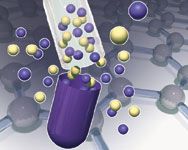Exploring Chiral Chemistry
PTSM: Pharmaceutical Technology Sourcing and Management
Chemocatalytic and biocatalytic approaches in asymmetric synthesis help provide a pathway for producing single-enantiomer drugs.
Producing the single enantiomer of a bioactive chiral compound is an ongoing challenge. Chemocatalysis and biocatalysis often are the key in asymmetric synthesis for producing a compound with desired yield and enantiopurity.

(IMAGE: DON BISHOP, BRAND X PICTURES, GETTY IMAGES)
Nonnatural amino acids
Nonnatural amino acids are important building blocks as chiral intermediates in small-molecule drug synthesis, and they also play a crucial role in peptide synthesis. Researchers at Vanderbilt University's Vanderbilt Institute of Chemical Biology in Nashville, Tennessee, recently reported on their work that addresses one of the limitations in peptide synthesis, the difficulty of incorporating nonnatural amino acids in peptides and controlling stereoselectivity. The team developed a novel way of making amide linkages (1).
Amides typically are made by combining the acyl group from a carboxylic acid derivative with an amine with the elimination of water. Although dehydrative approaches generally are used in amide formation, oxidative and radical-based methods also can be used. In amide-bond formation, carbon and nitrogen bear electrophilic and nucleophilic character, respectively, during the carbon–nitrogen bond-forming step (2).
The researchers' approach instead used a-halonitroalkanes as the acyl source. The amines and nitroalkanes were activated by an electrophilic iodine source that led directly to amide products. Preliminary observations supported a mechanism in which the polarities of the two reactants were reversed during carbon–nitrogen bond formation relative to traditional peptide synthesis. The nitroalkanes as acyl-anion equivalents provided a conceptually new route to amide and peptide synthesis and one that might allow for efficient peptide synthesis that relies on enantioselective methods (1, 2).
A team led by Eric Jacobsen, professor of chemistry in the Department of Chemistry and Chemical Biology at Harvard University, used organocatalysts, achiral thiourea-containing catalysts, for the asymmetric version of the Strecker synthesis. The Strecker synthesis is a series of chemical reactions that synthesize an amino acid from an aldehyde or ketone. Although chemocatalysis and enzymatic methods can be used to synthesize enantioenriched a-amino acids, synthesizing nonnatural amino acids is challenging. Alkene hydrogenation may be used in the enantioselective catalytic synthesis of many classes of amino acids, but it is not possible to obtain a-amino acids bearing aryl or quaternary alkyl a-substituents using this method (3, 4).

Patricia Van Arnum
The researchers addressed this problem through the Strecker synthesis, but used an organocatalyst that avoids the problem of using a precious metal catalyst to control a key step in the synthesis. The Strecker synthesis, which involves the reaction of an imine or imine equivalent with hydrogen cyanide, followed by nitrile hydrolysis, is used for the synthesis of racemic a-amino acids. In an asymmetric Strecker synthesis, stoichiometric amounts of a chiral reagent can yield enantiomerically enriched a-amino acids on gram and kilogram scales. The researchers reported that Strecker syntheses using substoichiometric quantities of a chiral reagent could be an alternative, but catalytic methods in this approach have been limited to preparative scales because of the complexity of the catalysts and the need to use hazardous cyanide sources (3, 4).
Instead, the researchers used a relatively simple chiral amido-thiourea catalyst to control the key hydrocyanation step for the syntheses of highly enantiomerically enriched nonnatural amino acids. The catalyst is compatible with aqueous cyanide salts, which are safer and easier to handle than other cyanide sources, thereby potentially making the method adaptable to large-scale synthesis. The researchers used this method to obtain enantiopure amino acids that are not readily prepared by enzymatic methods or by chemical hydrogenation (3, 4).
Chiral amines
Researchers at Merck & Co. (Whitehouse Station, NJ) and Codexis (Redwood, CA,) a company specializing in biocatalysis, recently reported on their work on the biocatalytic asymmetric synthesis of chiral amines from ketones in the manufacture of sitagliptin, the active ingredient in Merck's antidiabetes drug Januvia. The biocatalytic process replaced a rhodium-catalyzed asymmetric enamine hydrogenation for the large-scale manufacture of sitagliptin. The researchers started from an (R)-selective transaminase that showed slight activity on a smaller truncated methyl ketone analog of the sitagliptin ketone. After creating this transaminase, which had marginal activity for the synthesis of the chiral amine, they further engineered the enzyme through directed evolution to optimize its use for large-scale manufacturing. The initial (R)-selective transaminase was a homologue of an enzyme from Arthrobacter sp., which previously was used for (R)-specific transamination of methyl ketones and small cyclic ketones. For the sitagliptin synthesis, the researchers generated a structural homology model of this transaminase and found that the enzyme would not bind to the prositagliptin ketone because of steric interference and potentially undesired interactions. The evolved transaminase was a successful biocatalyst that synthesized the chiral amines that previously were accessible only through resolution (5, 6).
The research was given the Greener Reaction Conditions Award by the US Environmental Protection Agency's Presidential Green Chemistry Challenge Awards in June 2010, an annual recognition of green-chemistry applications. The evolved transaminase had a compounded improvement in biocatalytic activity of more than 25,000-fold with high enantiopurity and no detection of the (S)-enantiomer of sitagliptin being formed. The enzymatic approach eliminated the high-pressure hydrogenation route, metal catalysts (i.e., rhodium and iron), and additional chiral purification steps in the rhodium-catalyzed asymmetric enamine hydrogenation for the large-scale manufacture of sitagliptin. The biocatalytic route improved productivity by 56%, increased yield by 10–13%, and reduced waste by 19%. Merck scaled up the process to pilot scale in 2009, according to information from EPA (6).
Diels–Alder reactions
Researchers recently reported on the use of computational design of a biocatalyst for stereoselective bimolecular Diels–Alder reactions. Diels–Alder is a cycloaddition reaction between a conjugated diene and a substituted alkene to form a substituted cyclohexene system. The researchers noted that no naturally occurring enzyme has been shown to catalyze an intermolecular Diels–Alder reaction, a function that could be valuable in increasing reaction rates and stereoselectivity. The researchers developed a de novo computational design and experimental characterization of enzymes catalyzing a bimolecular Diels–Alder reaction with high stereoselectivity and substrate specificity. The researchers studied the Diels–Alder reaction between 4-carboxybenzyl trans-1,3-butadiene-1-carbamate and N,N-dimethylacrylamide (7).
The researchers previously used Rosetta computational design methodology to design enzymes for catalyzing bond-breaking reactions, so their challenge was to develop a computational design for bond-forming reactions. Bimolecular bond-forming reactions, however, present a greater challenge because both substrates must be bound in the proper relative orientation for the reaction to accelerate and achieve stereoselectivity. Their work involved general acid–base catalysis and covalent catalysis. The Diels–Alder reaction provided the opportunity to alter the reaction rate by modulating molecular orbital energies (7).
Although the researchers succeeded in computationally designing an enzyme that catalyzes an enantio and diastereoselective intermolecular reaction, they noted the need to further improve their computational design methods. Only 2 of the 50 designed enzymes tested had measurable activity, and higher success rates and higher overall activities are desirable. However, their work holds promise. In addition to catalyzing new reactions with high substrate specificity and stereoselectivity, one of the potential advantages of the de novo enzyme design is that once an initial active enzyme is engineered, it can be modified to catalyze similar reactions with other substrates.
Patricia Van Arnum is a senior editor at Pharmaceutical Technology, 485 Route One South, Bldg F, First Floor, Iselin, NJ 08830 tel. 732.346.3072, pvanarnum@advanstar.com.
References
1. B. Shen, D. Makley, and J.N. Johnston, Nature 465 (7301), 1027–1032 (2010).
2. S. Borman, Chem. Eng. News 88 (26), 13 (2010).
3. C. Dahl, Chem. Eng. News 87 (42), 10 (2009).
4. E. Jacobsen et al., Nature 461 (7268), 968–970 (2009).
5. C.K. Savile et al., Science 329 (5989), 305–309 (2010).
6. EPA, "The Presidential Green Chemistry Challenge Awards Program: Summary of 2010 Award Entries and Recipients" (EPA, Washington, DC, 2010).
7. J.B. Siegel et al., Science 329 (5989), 309–313 (2010).
3D Screen Printing: Enabling A New Generation of Complex Formulations
April 14th 20253D screen printing provides innovative drug development capabilities that are difficult or impossible to achieve with traditional methods, including complex multi-layered formulations, precision control over drug release profiles, and near-endless possibilities in the geometric shaping of dosage forms. In this article, learn how 3D screen printing offers unmatched flexibility to tailor formulations for specific therapeutic needs and redefines what’s possible in drug development and manufacturing.
Transformations in Drug Development for Cell and Gene Therapies
March 28th 2025As a recognized leader in immunophenotyping for clinical trials, Kevin Lang from PPD discusses how spectral flow cytometry is transforming drug development, particularly in cell and gene therapies like CAR-T. He also dives into his award-winning research, including his 2024 WRIB Poster Award-winning work, and his insights from presenting at AAPS PharmSci360.
Advancing Clinical Trials with Spectral Flow Cytometry: A Conversation with Kevin Lang
March 28th 2025As a recognized leader in immunophenotyping for clinical trials, Kevin Lang from PPD discusses how spectral flow cytometry is transforming drug development, particularly in cell and gene therapies like CAR-T. He also dives into his award-winning research, including his 2024 WRIB Poster Award-winning work, and his insights from presenting at AAPS PharmSci360.